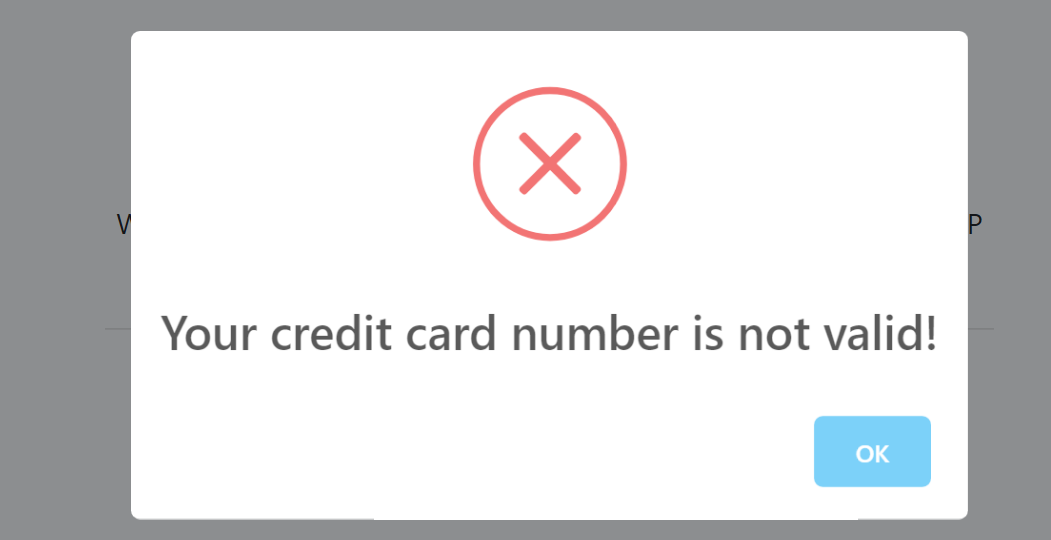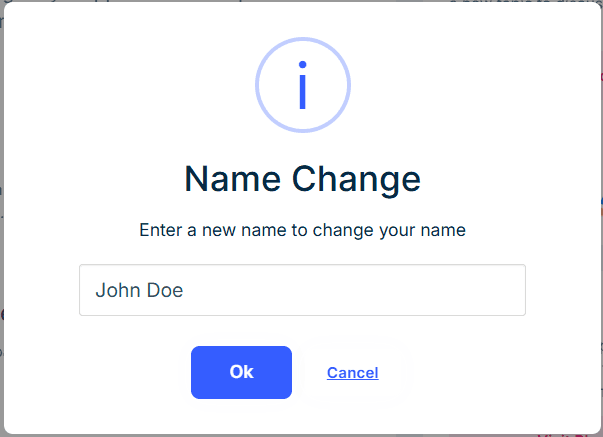ASP.NET Core MVC / Razor Pages UI: JavaScript Message API
Message API is used to show nice looking messages to the user as a blocking dialog. Message API is an abstraction provided by the ABP and implemented using the SweetAlert library by default.
Quick Example
Use abp.message.success(...) function to show a success message:
abp.message.success('Your changes have been successfully saved!', 'Congratulations');
It will show a dialog on the UI:

Informative Messages
There are four types of informative message functions:
abp.message.info(...)abp.message.success(...)abp.message.warn(...)abp.message.error(...)
All these methods get two parameters:
message: The message (string) to be shown.title: An optional (string) title.
Example: Show an error message
abp.message.error('Your credit card number is not valid!');

Confirmation Message
abp.message.confirm(...) function can be used to get a confirmation from the user.
Example
Use the following code to get a confirmation result from the user:
abp.message.confirm('Are you sure to delete the "admin" role?')
.then(function(confirmed){
if(confirmed){
console.log('TODO: deleting the role...');
}
});
The resulting UI will be like shown below:

If user has clicked the Yes button, the confirmed argument in the then callback function will be true.
"Are you sure?" is the default title (localized based on the current language) and you can override it.
The Return Value
The return value of the abp.message.confirm(...) function is a promise, so you can chain a then callback as shown above.
Parameters
abp.message.confirm(...) function has the following parameters:
message: A message (string) to show to the user.titleOrCallback(optional): A title or a callback function. If you supply a string, it is shown as the title. If you supply a callback function (that gets aboolparameter) then it's called with the result.callback(optional): If you've passes a title to the second parameter, you can pass your callback function as the 3rd parameter.
Passing a callback function is an alternative to the then callback shown above.
Example: Providing all the parameters and getting result with the callback function
abp.message.confirm(
'Are you sure to delete the "admin" role?',
'Be careful!',
function(confirmed){
if(confirmed){
console.log('TODO: deleting the role...');
}
});
Prompt Message
abp.message.prompt(...) can be used to get a text (or other input) from the user.
Simple usage:
abp.message.prompt('Please enter a name:', (value)=> console.log('Entered name:', value));
Example (then):
let options = { title: "Name Change" ,icon: "info", inputValue: "John Doe"};
abp.message.prompt('Enter a new name to change your name', options)
.then(function(value){
if (value) {
console.log('Entered name:', value);
}
});
Example (await):
(async function(){
let options = { title: "Email Registration" ,icon: "info", input: "email"};
const email = await abp.message.prompt('Enter your email:', options);
if (email) {
console.log('Entered email:', email);
}
})();

The Return Value
The return value of the abp.message.prompt(...) function is a promise that resolves to the entered value (string) or null if the dialog is canceled/dismissed.
Parameters
abp.message.prompt(...) function has the following parameters:
message: A message (string) to show to the user.titleOrOptionsOrCallback(optional):- a
stringtitle, or - an
objectcontaining SweetAlert options (e.g.,input,inputAttributes,inputPlaceholder), or - a
functioncallback that receives the resulting value (ornull).
- a
callback(optional): If you've passed a title as the second parameter, you can pass your callback function as the 3rd parameter.
Passing a callback function is an alternative to using the returned promise.
SweetAlert Configuration
The Message API is implemented using the SweetAlert library by default. If you want to change its configuration, you can set the options in the abp.libs.sweetAlert.config object. The default configuration object is shown below:
{
'default': {
},
info: {
icon: 'info'
},
success: {
icon: 'success'
},
warn: {
icon: 'warning'
},
error: {
icon: 'error'
},
confirm: {
icon: 'warning',
title: 'Are you sure?',
buttons: ['Cancel', 'Yes']
}
}
"Are you sure?", "Cancel" and "Yes" texts are automatically localized based on the current language.
So, if you want to set the warn icon, you can set it like:
abp.libs.sweetAlert.config.warn.icon = 'error';
See the SweetAlert document for all the configuration options.


























































